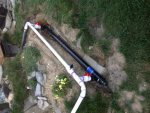crsublette
coyotes call me Charles
Mucky_Waters said:1) Just a quick search, I came up with this product page for Aqua Ultraviolet Classic 57 watt UV, they list specific flow rates, UV exposure rates at those flow rates, and pond volumes for their unit, for different functions (eg clarifier vs sterilizer), also it goes on to say "A sterilizer will eliminate green water and control bacteria. The Classic 57 Watt, will sterilize up to 3,000 gallons of fresh water or 355 gallons of salt water." I'm sure I read other manufacturers in the past with similar claims and specs, and that how I made my educated guess that my UV unit is functioning as a sterilizer at the flow rates, and pond size I have. That is, when I turn it on anyway.
The link you provided talks about several things, including UV wavelength, and reduced effectiveness of the UV due to dirty quarts sleeve and water turbidity. These are of course things that can effect any UV unit, no mater what the wattage or price the unit it. It also goes on to say "We suggest oversizing the UV sterilizer by at least 40 percent to be sure of getting the killing power required when the lamp has aged". This is something I agree with wholeheartedly, and one of the reasons I advocate spending the money on a more powerful cheaper unit, as opposed to buying a more expensive lower watt unit.
2) I must admit though, I'm a bit confused by the UV exposure rates sited on the link you provided. (The required UV exposure rate to irradiate common bacteria is 15,000 µWs/cm² , while the required UV exposure for waterborne algae is 22,000 µWs/cm² .) It seems to be saying that it takes less UV rays to kill (irradiate) bacteria then it does to to kill waterborne bacteria???
2) I must admit though, I'm a bit confused by the UV exposure rates sited on the link you provided. (The required UV exposure rate to irradiate common bacteria is 15,000 µWs/cm² , while the required UV exposure for waterborne algae is 22,000 µWs/cm² .) It seems to be saying that it takes less UV rays to kill (irradiate) bacteria then it does to to kill waterborne [algae]???
Not for sure what you're asking here.
I believe the source for those numbers came from the Aquacultural Engineering book, which unfortunately I do not have the funds to purchase and to verify the table data. It would be interesting to know of other sources out there that list the µWs/cm² for an appopriate kill by a UV.
1) Just a quick search, I came up with this product page for Aqua Ultraviolet Classic 57 watt UV, they list specific flow rates, UV exposure rates at those flow rates, and pond volumes for their unit, for different functions (eg clarifier vs sterilizer), also it goes on to say "A sterilizer will eliminate green water and control bacteria. The Classic 57 Watt, will sterilize up to 3,000 gallons of fresh water or 355 gallons of salt water." I'm sure I read other manufacturers in the past with similar claims and specs, and that how I made my educated guess that my UV unit is functioning as a sterilizer at the flow rates, and pond size I have. That is, when I turn it on anyway.
Yeah, unfortunately, certain data points we simply just have to rely on the company or their hand chosen independent laboratories.
Rather than taking the company's word for it, lets evaluate their data points by what we know now. Sterilize what exactly?? Unfortunately, this is how companies like to play word games with their consumers in conflating the words clarifying and sterilizing..
What's their definition of " to sterilize " ?? Well, to figure this, one would have to find the appropriate resources to know what µWs/cm² is required for a good UV kill.
As mentioned in their hyperlink, for the Classic 57 watt, the estimated sterilization at 3,200gph is 30,0000µWs/cm² and, with the same device, the estimated sterilization at 1,066gph is 90,000µWs/cm².
At 30,0000µWs/cm², ya get a kill of most of the common bacteria, common pathogens, some spores, and floating algae.
At 90,000µWs/cm², that is half the Classic57's flow rate, ya get the above kill plus some anaerobic bacteria, common fungus, egg fungus, mold, another pathogen, possibly nematode eggs, and finally a parasite (that is trichodina)
Then, you can go even higher than this, cut the Classic57's flow rate to somewhere around 355gph and you will get a 270,000µWs/cm², which this would kill all of the above plus more parasites, a protozoa, and an actual virus.
According to Aquatic Eco-Systems (AES) and the devices µWs/cm² emission, the Classic 57 watt would be a clarifier when the flow rate is a little higher than 3,200gph and a sterilizer at 1,066gph.
I suppose it depends on one's definition of sterilizer. My definition of sterilizer would be a UV device that actually starts killing the stuff that is tough to kill, that is if it is floating in the water and passing through the UV device.
Now, according to their statement, a pond turn over rate of 0.35 per hour is quite fine, which this I would like to see to be high simply due to personal belief. It would be nice if they could give an explanation to the low pond turn over rate recommendation for the Classic 57 device to work fine as a sterilizer.
When I think sterilizer, then I am thinking of something with a kill rate of 90,000µWs/cm²~270,000µWs/cm², which would mean a flow rate of around 355gph~1,066gph from the Classic57 watt.
So, unfortunately since how folk like to play word games, then it gets a bit aggravating.
For a hobbiest, meh, all this is quite irrelevant, but I think it is quite interesting to know for folk interested in knowing if all this UV stuff actually matters.

